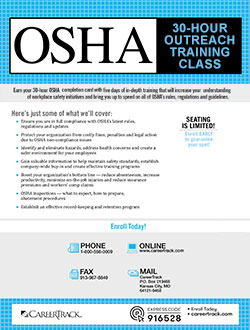Earn Your OSHA 30-Hour Completion Card in Just Five Days
Join our OSHA 30-hour training and gain comprehensive, practical knowledge of workplace safety regulations. This in-depth OSHA training course equips you with the tools to enhance employee well-being, meet OSHA compliance training standards, and avoid the financial and legal consequences of non-compliance.
Through five full days of instruction, you’ll earn your official OSHA completion card while learning to interpret and apply OSHA’s complex rules and regulations with confidence. Whether you manage safety programs or work on the front lines, this OSHA certification class empowers you to promote a safer, more productive workplace.
What You’ll Learn in This OSHA Certification Class
- Stay current with OSHA’s latest rules, updates, and regulatory guidelines
- Protect your organization from fines, penalties, and legal exposure due to OSHA non-compliance
- Identify and eliminate safety hazards, resolve health issues, and foster a secure work environment
- Gain insights to uphold OSHA safety standards and implement effective company-wide training programs
- Improve financial outcomes by lowering absenteeism, reducing injuries, and cutting insurance premiums and workers’ comp claims
- Prepare for OSHA inspections with confidence, including abatement procedures and documentation expectations
- Establish efficient recordkeeping and retention practices to maintain compliance
Why OSHA Compliance Training Matters
According to the U.S. Department of Labor, U.S. businesses lose $170 billion annually due to workplace injuries and illnesses. These losses impact productivity, employee morale, and service quality while driving up retraining costs, insurance premiums, and workers’ comp claims.
Falling behind on OSHA regulations can put your organization at risk. This OSHA training course is designed to help you understand OSHA requirements and adopt best practices that protect your workforce and bottom line.
Comprehensive Workplace Safety Training That Works
This OSHA 30-hour training offers an immersive experience that breaks down hazard identification, prevention, and mitigation. Your instructor will guide you through OSHA’s general industry standards in a way that’s easy to absorb and apply. You’ll return to the workplace with actionable skills and a deeper understanding of how to implement effective safety practices.
From creating internal safety protocols to cultivating a culture of health and safety, this OSHA compliance training supports your goals without overwhelming you with excessive information. The course is interactive, practical, and results-driven.
A Safer Workforce Means a Stronger Business
When employees feel protected and valued, job satisfaction and performance improve. A safe workplace fosters optimism, boosts morale, and promotes long-term retention. Investing in OSHA certification training is more than a regulatory requirement—it’s a strategic decision that enhances employee engagement and supports your organization’s success.
